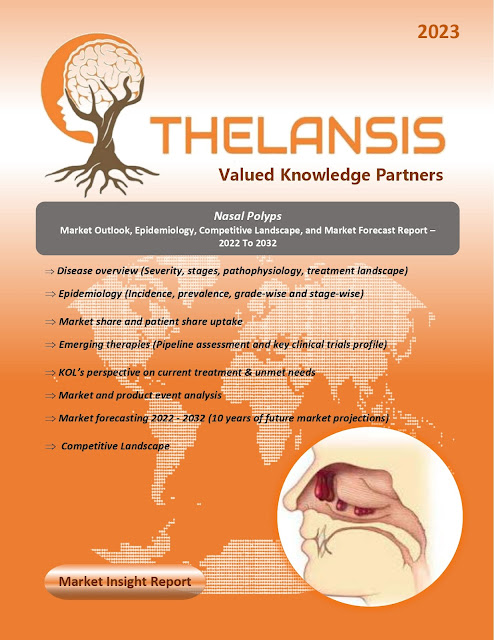Nasal Polyps – Market Outlook, Epidemiology, Competitive Landscape, and Market Forecast Report – 2022 To 2032
Nasal polyps, benign outgrowths of the sinonasal mucosa resulting from inflammation and hyperplasia, commonly appear in individuals with chronic rhinosinusitis (CRS). The term "chronic rhinosinusitis with nasal polyposis" (CRSwNP) is frequently used when discussing nasal polyps. The prevalent symptoms of nasal polyps encompass nasal congestion, runny nose, facial sinus fullness (typically without pain), postnasal drip, reduced sense of smell, a sensation of nasal blockage, and the need to breathe through the mouth. In addition to their connection with chronic rhinosinusitis, nasal polyps are linked to conditions such as aspirin-exacerbated respiratory disease (AERD), certain systemic vasculitis, and cystic fibrosis. These polyps can be categorized into localized, diffuse, and systemic. Localized nasal polyps usually arise from reactive inflammatory or neoplastic processes. Diffuse nasal polyposis is often observed in individuals with CRSwNP, with diverse underlying causes. Various factors characterize the pathophysiology of nasal polyps. As individuals age, physiological changes occur in the body, accumulating thick mucus and reducing ability to clear irritants and pathogens like viruses, bacteria, and fungi. These changes involve a decline in ciliary beat frequency, impaired mucociliary clearance, atrophy of the sinonasal mucosa with decreased vasculature, and diminished mucus secretion. The differential diagnosis of nasal polyps is expansive, necessitating histologic confirmation in most cases. Potential diagnoses include Antrochoanal polyps, Inverted papillomas, Schneiderian papillomas, Squamous cell carcinoma (SCC), Non-Hodgkin lymphoma, Melanoma, and Esthesioneuroblastoma. The specific disease endotype influences the prognosis of nasal polyps. Additional prognostic factors linked to unfavorable outcomes comprise younger age at onset, higher Lund-Mackay scores, significant global osteitis, and elevated tissue eosinophilia/neutrophilia.
Thelansis’s “Nasal Polyps Market
Outlook, Epidemiology, Competitive Landscape, and Market Forecast Report – 2022
To 2032" covers disease overview, epidemiology, drug utilization,
prescription share analysis, competitive landscape, clinical practice,
regulatory landscape, patient share, market uptake, market forecast, and key
market insights under the potential Nasal Polyps treatment modalities options
for eight major markets (USA, Germany, France, Italy, Spain, UK, Japan, and
China).
KOLs insights
of Nasal Polyps across 8 MM market from the centre of Excellence/ Public/
Private hospitals participated in the study. Insights around current treatment
landscape, epidemiology, clinical characteristics, future treatment paradigm,
and Unmet needs.
Nasal Polyps Market Forecast Patient
Based Forecast Model (MS. Excel Based Automated Dashboard), which Data Inputs
with sourcing, Market Event, and Product Event, Country specific Forecast
Model, Market uptake and patient share uptake, Attribute Analysis, Analog
Analysis, Disease burden, and pricing scenario, Summary, and Insights.
Thelansis Competitive Intelligence (CI) practice
has been established based on a deep understanding of the pharma/biotech
business environment to provide an optimized support system to all levels of
the decision-making process. It enables business leaders in forward-thinking
and proactive decision-making. Thelansis supports scientific and commercial
teams in seamless CI support by creating an AI/ ML-based technology-driven
platform that manages the data flow from primary and secondary sources.




Comments
Post a Comment